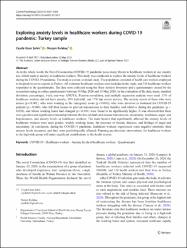| dc.contributor.author | Şahin, Ceyda Uzun | |
| dc.contributor.author | Kulakaç, Nursen | |
| dc.date.accessioned | 2022-08-16T08:14:00Z | |
| dc.date.available | 2022-08-16T08:14:00Z | |
| dc.date.issued | 2021 | en_US |
| dc.identifier.citation | Şahin, C. U., & Kulakaç, N. (2022). Exploring anxiety levels in healthcare workers during COVID-19 pandemic: Turkey sample. Current psychology (New Brunswick, N.J.), 41(2), 1057–1064. https://doi.org/10.1007/s12144-021-01730-7 | en_US |
| dc.identifier.issn | 1046-1310 | |
| dc.identifier.issn | 1936-4733 | |
| dc.identifier.uri | https://doi.org/10.1007/s12144-021-01730-7 | |
| dc.identifier.uri | https://hdl.handle.net/11436/6360 | |
| dc.description.abstract | As in the whole world, the Novel Coronavirus (COVID-19) pandemic poses many threats to healthcare workers in our country too, which leads to anxiety in healthcare workers. This study was conducted to explore the anxiety levels of healthcare workers during the COVID-19 pandemic. The study is a cross-sectional study. The population consisted of health care workers employed in hospitals in seven regions in Turkey. All volunteer healthcare workers were included in the study, and 356 healthcare workers responded to the questionnaire. The data were collected using the State Anxiety Inventory and a questionnaire created by the researchers using an online questionnaire between 10 May 2020 and 15 May 2020. In the evaluation of the data, mean, standard deviation, percentages, t-test, one-way ANOVA, Pearson correlation, and multiple regression analysis were used. 33% of healthcare workers did not have anxiety, 50% had mild, and 17% had severe anxiety. The anxiety scores of those who were nurses (p < 0.001), who were working in the emergency room (p < 0.001), who were involved in treatment for COVID-19 patients (p = 0.040), who left their homes to prevent transmission to their families and relatives during the pandemic (p = 0.038), and whose working hours had changed (p = 0.036) were found to be significantly higher. It was observed that there was a positive and significant relationship between the fear of death and disease transmission, uncertainty, loneliness, anger, and hopelessness, and anxiety levels in healthcare workers. The main factors that significantly affected the anxiety levels of healthcare workers were male gender, weekly working hours, the presence of chronic diseases, and feelings of anger and uncertainty. In conclusion, during the COVID-19 pandemic, healthcare workers experienced some negative emotions, their anxiety levels increased, and they were psychologically affected. Planning psychosocial interventions for healthcare workers in the high-risk group will make significant contributions to the health system. | en_US |
| dc.language.iso | eng | en_US |
| dc.publisher | Springer | en_US |
| dc.rights | info:eu-repo/semantics/openAccess | en_US |
| dc.subject | COVID-19 | en_US |
| dc.subject | Healthcare workers | en_US |
| dc.subject | Anxiety levels of healthcare workers | en_US |
| dc.subject | Questionnaire | en_US |
| dc.title | Exploring anxiety levels in healthcare workers during COVID-19 pandemic: Turkey sample | en_US |
| dc.type | article | en_US |
| dc.contributor.department | RTEÜ, Sağlık Hizmetleri Meslek Yüksekokulu, Tıbbi Hizmetler ve Teknikler Bölümü | en_US |
| dc.contributor.institutionauthor | Şahin, Ceyda Uzun | |
| dc.identifier.volume | 41 | en_US |
| dc.identifier.issue | 2 | en_US |
| dc.identifier.startpage | 1057 | en_US |
| dc.identifier.endpage | 1064 | en_US |
| dc.relation.journal | Current Psychology | en_US |
| dc.relation.publicationcategory | Makale - Uluslararası Hakemli Dergi - Kurum Öğretim Elemanı | en_US |


















